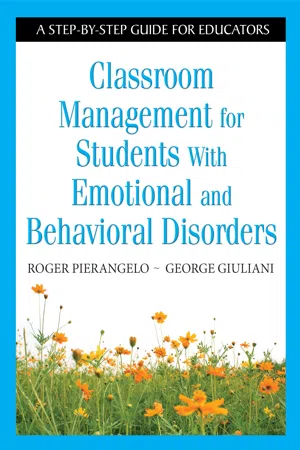
Classroom Management for Students With Emotional and Behavioral Disorders
A Step-by-Step Guide for Educators
- 152 pages
- English
- ePUB (mobile friendly)
- Available on iOS & Android
Classroom Management for Students With Emotional and Behavioral Disorders
A Step-by-Step Guide for Educators
About this book
"General education teachers need more information and guidance on how to effectively work with students with emotional and behavioral disorders. This book provides an overview of the various needs and characteristics that many of these students display."
—Emily Wilmes, Emotional Behavioral Disorder Teacher
Roosevelt Elementary School, Mankato, MN
Effective methods for teaching students with emotional and behavioral disorders!
Written by experts in the field of special education, this guide provides a clear and comprehensive overview of emotional and behavioral disorders (EBD), along with practical guidelines for working with students diagnosed with EBD.
Aligned with the reauthorization of IDEA 2004, these effective and culturally sensitive techniques help teachers understand and distinguish typical behavior from the symptoms, problems, and characteristics of EBD, such as moodiness, argumentative behavior, anger, difficulty interacting with peers, refusing to share, and inability or unwillingness to take responsibility.
Ideal for general and special education teachers, this step-by-step resource includes references, a glossary, and information about:
- Positive reinforcements and effective instructional interventions for the classroom
- Federal regulations related to students with EBD
- Ways to promote healthy social interactions
- Classroom management strategies for specific disorders
Classroom Management for Students With Emotional and Behavioral Disorders provides invaluable guidance for redirecting students toward more appropriate behaviors, building important social skills, and establishing a positive classroom climate for all learners.
Frequently asked questions
- Essential is ideal for learners and professionals who enjoy exploring a wide range of subjects. Access the Essential Library with 800,000+ trusted titles and best-sellers across business, personal growth, and the humanities. Includes unlimited reading time and Standard Read Aloud voice.
- Complete: Perfect for advanced learners and researchers needing full, unrestricted access. Unlock 1.4M+ books across hundreds of subjects, including academic and specialized titles. The Complete Plan also includes advanced features like Premium Read Aloud and Research Assistant.
Please note we cannot support devices running on iOS 13 and Android 7 or earlier. Learn more about using the app.
Information

Step VII
Understand and Implement Classroom Management Strategies for Students With Specific Psychological Disorders
Child and Adolescent Mental Health and Schools
Risk Factors
Biological
Adverse Psychosocial Development
Mental Disorders With Onset in Children and Adolescents
Warning Signs That a Child or Adolescent May Need Mental Health Services
Emotions
Big Changes
Experiences/Behaviors
Role of the School















Table of contents
- Cover
- Dedication
- Title Page
- Copyright
- Contents
- Preface
- Acknowledgments
- About the Authors
- Step I. Review Your Knowledge of Students With Emotional and/or Behavioral Disorders
- Step II. Understand the Behaviors of Students With Emotional and/or Behavioral Disorders
- Step III. Become Culturally Competent When Working With Students With Emotional and/or Behavioral Disorders
- Step IV. Understand and Apply Principles of Reinforcement When Working With Students With Emotional and/or Behavioral Disorders
- Step V. Promote Positive Social Interactions Among Students With Emotional and/or Behavioral Disorders
- Step VI. Apply Instructional Interventions for Specific Behaviors Exhibited in the Classroom by Students With Emotional and/or Behavioral Disorders
- Step VII. Understand and Implement Classroom Management Strategies for Students With Specific Psychological Disorders
- Glossary
- References
- Index